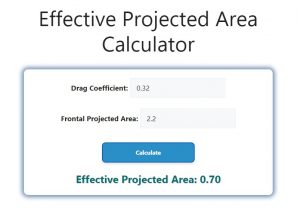About Effective Projected Area Calculator (Formula)
The Effective Projected Area Calculator is an essential tool in the fields of engineering, aerodynamics, and automotive design. It helps estimate the drag force experienced by an object moving through a fluid, such as air or water, by calculating its effective projected area. This measurement is crucial for improving fuel efficiency, optimizing vehicle design, and understanding the performance characteristics of various objects. By accurately calculating the effective projected area (EPA), engineers can make informed decisions regarding design modifications and performance enhancements.
Formula
The formula used in the Effective Projected Area Calculator is: EPA = D * FPA, where EPA represents the effective projected area, D is the drag coefficient, and FPA is the frontal projected area. This relationship allows users to determine how the shape and orientation of an object affect its resistance to airflow, which is critical for achieving optimal aerodynamic performance.
How to Use
Using the Effective Projected Area Calculator is straightforward. Here’s a step-by-step guide:
- Input Drag Coefficient (D): Enter the drag coefficient, which is a dimensionless number representing the drag per unit area of the object. This value varies based on the shape and surface texture of the object.
- Input Frontal Projected Area (FPA): Enter the frontal projected area of the object in square meters (m²). This area represents the size of the object as viewed from the front.
- Calculate: Click the “Calculate” button to obtain the effective projected area. The result will help you understand how aerodynamic factors influence the object’s performance.
Example
Let’s consider an example to illustrate how to use the Effective Projected Area Calculator:
- Drag Coefficient (D): 0.32 (a typical value for a compact car)
- Frontal Projected Area (FPA): 2.2 m²
Using the formula:
EPA = D * FPA
EPA = 0.32 * 2.2
EPA = 0.704 m²
In this example, the effective projected area is 0.704 square meters, which will be essential for further calculations involving drag force and performance metrics.

FAQs
1. What is the drag coefficient?
The drag coefficient is a dimensionless number that quantifies the drag or resistance of an object in a fluid environment, such as air or water.
2. How is the frontal projected area defined?
The frontal projected area is the area of an object as viewed from the front, typically measured in square meters (m²).
3. Why is the effective projected area important?
The effective projected area is crucial for determining the aerodynamic drag force on an object, which affects its performance and fuel efficiency.
4. How does the shape of an object influence its drag coefficient?
Streamlined shapes typically have lower drag coefficients, while blunt or irregular shapes have higher coefficients, leading to increased drag.
5. Can I use this calculator for different types of vehicles?
Yes, the Effective Projected Area Calculator can be used for various vehicles and objects, including cars, trucks, airplanes, and more.
6. How do I find the drag coefficient for my object?
The drag coefficient can be obtained from experimental data, engineering handbooks, or computational fluid dynamics simulations.
7. What happens if I input incorrect values?
Inputting incorrect values will lead to inaccurate results for the effective projected area, affecting any subsequent calculations related to drag force.
8. Can this calculator be used in aerospace applications?
Yes, the Effective Projected Area Calculator is widely used in aerospace applications to assess the performance of aircraft and spacecraft.
9. How do environmental factors affect drag?
Factors such as air density, temperature, and wind speed can influence drag forces, but the calculator primarily focuses on shape and size.
10. Is there a standard value for the drag coefficient of cars?
The drag coefficient for modern cars typically ranges from 0.25 to 0.35, depending on the design and aerodynamics of the vehicle.
11. Can I use this calculator for non-vehicular objects?
Absolutely! The calculator can be applied to any object moving through a fluid, such as projectiles, buildings, or bridges.
12. What units are used in the Effective Projected Area Calculator?
The drag coefficient is dimensionless, and the frontal projected area is measured in square meters (m²).
13. How does reducing the frontal area impact performance?
Reducing the frontal area typically decreases drag, improving fuel efficiency and overall performance.
14. Can I combine multiple objects in the calculation?
The calculator is designed for individual objects, but you can perform multiple calculations for different objects and sum the results.
15. What role does surface texture play in the drag coefficient?
Surface texture can significantly impact the drag coefficient; smoother surfaces typically yield lower drag than rough ones.
16. How do I interpret the results from the calculator?
The output represents the effective projected area, which can be used in further calculations to assess aerodynamic performance and drag forces.
17. How often should I calculate effective projected area for a new design?
It’s advisable to calculate the effective projected area for each design iteration to understand how changes affect performance.
18. Can software tools provide more detailed drag coefficient values?
Yes, advanced computational fluid dynamics software can simulate airflow around objects to provide precise drag coefficient values.
19. What is the relationship between effective projected area and fuel efficiency?
A lower effective projected area typically leads to reduced drag forces, resulting in better fuel efficiency for vehicles.
20. Are there any online tools available for calculating drag coefficients?
Yes, many online resources and calculators can help you find drag coefficients for various objects based on design parameters.
Conclusion
The Effective Projected Area Calculator is a valuable tool for engineers, designers, and researchers seeking to optimize the aerodynamic performance of various objects. By understanding the relationship between drag coefficient, frontal projected area, and effective projected area, users can make informed decisions that enhance performance, fuel efficiency, and overall effectiveness. Whether in automotive design, aerospace engineering, or general fluid dynamics, this calculator plays a crucial role in achieving superior results.